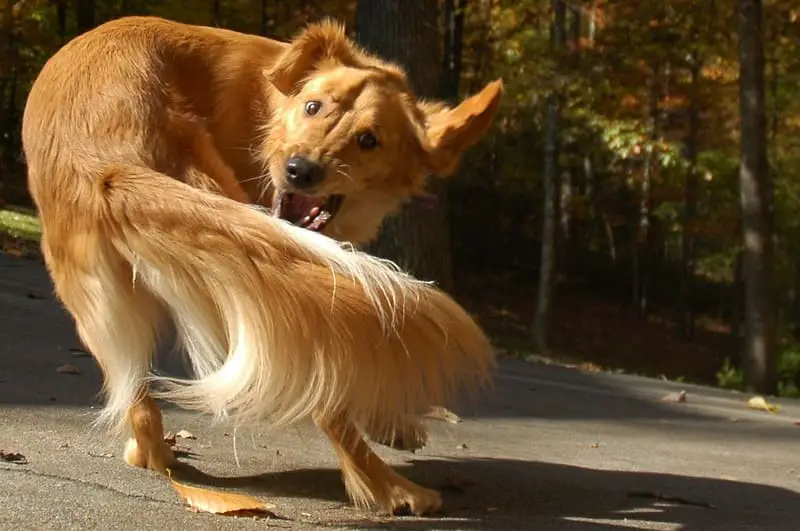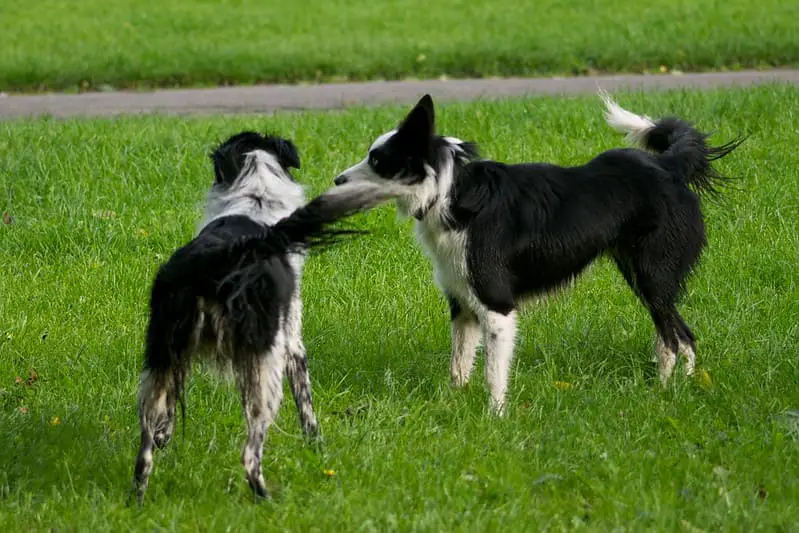If you’re a dog owner, you’ve probably witnessed your pup chasing their tail on occasion. Sometimes it may be just the odd, quick chase, and other times your dog may resemble a tornado, whirling around and around in hot pursuit of their tail. When it’s only occasional and doesn’t seem to be doing your dog any harm, it’s usually harmless behavior. However, if the tail chasing appears to be obsessive, then there could be a dog health issue. In this comprehensive guide, we will delve into the reasons behind this behavior, ranging from playfulness to medical conditions, and provide insights into how to address it.

Reasons Why Dogs Chase Their Tails
Dogs chase their tails for various reasons, and understanding these motivations can help dog owners address the behavior effectively. Here are six detailed reasons why dogs chase their tails:
1. Boredom
One common reason dogs chase their tails is boredom. Dogs, like humans, can get restless when they lack mental and physical stimulation. Tail chasing can serve as a way for them to entertain themselves for a while and expend excess energy. Fortunately, addressing boredom-related tail chasing is relatively simple. By increasing your dog’s daily activity through regular walks and introducing physical and mental games, you can reduce this behavior. Activities like fetch and brain puzzles are excellent ways to engage your dog’s mind and body.
2. Playfulness in Puppies
Puppies, much like human children, are curious and playful by nature. Their tail chasing could be attributed to their youthful exuberance and a way for them to explore their world. As puppies grow, they discover new things about themselves, including their tails. This behavior is often a phase that they will outgrow as they mature.
3. Fleas and Ticks
Fleas and ticks can cause dogs to chase their tails. An infestation can lead to intense itching, and dogs may chase their tails in an attempt to relieve the discomfort. If you suspect this behavior is related to fleas and ticks, check your dog’s skin for evidence, such as small, dark brown to black specks in their coat (flea feces) and bald patches resulting from excessive licking or scratching. It’s essential to address fleas and ticks promptly to alleviate your dog’s discomfort.
4. Attention-Seeking
Dogs are social animals and often seek attention from their owners. Tail chasing can be a way for them to garner attention, even if it’s in the form of reprimands. To your dog, any interaction is better than none, so they may continue tail chasing to elicit a response from you. It’s crucial to allocate time each day for quality interaction with your dog to prevent attention-seeking behaviors.
5. Medical Conditions
Tail chasing can be a symptom of underlying medical conditions. Dogs that obsessively chase their tails might be experiencing health issues, including seizures, pain, infections, or even cancer. If your dog engages in excessive tail chasing, it’s advisable to consult with your vet to rule out any medical problems and identify the root cause.
6. Anxiety
Anxiety can lead to tail chasing in dogs. Repetitive behaviors like tail chasing can be soothing for dogs and may serve as a coping mechanism for stress. Several factors, such as small living spaces, aggression from other pets, lack of socialization, past traumatic experiences, or abuse, can contribute to anxiety in dogs. Dogs that have experienced these stressors are more likely to develop compulsive behaviors. If anxiety-related compulsion is suspected, it’s wise to consult a professional behaviorist who can provide guidance on how to help your dog.

When to Be Concerned About Tail Chasing
While it’s not uncommon for dogs to chase their tails occasionally, certain circumstances may warrant concern. Here are some situations when tail chasing should be addressed more urgently:
- Obsessive Behavior: If tail chasing transforms from a sporadic, playful activity into an obsessive, compulsive behavior that interferes with your dog’s daily life, it’s a cause for concern.
- Biting Their Tail: When dogs start biting their tails during the chasing behavior, it indicates a heightened level of obsession and can lead to self-injury. Immediate action is necessary in such cases.
Why Do Dogs Chew Their Tails?
In some instances, dogs may chew their tails, which is a related behavior to tail chasing. The reasons for tail chewing can vary, and it’s important to differentiate between normal behaviors and potential medical issues. Here are some common reasons why dogs chew their tails:
1. Pain
Dogs may chew at their tails if they’re experiencing pain in that area. This behavior can be an attempt to alleviate discomfort.
2. Allergic Reactions
Allergies can cause itching and discomfort, leading dogs to chew their tails as a way to find relief from the irritation.
3. Fleas
Flea infestations often affect the base of a dog’s tail, leading to intense itching and tail chewing.
4. Intestinal Parasites
Dogs with intestinal parasites may chew their tails to ease the irritation caused by these parasites.
5. Anxiety
Anxiety can also trigger tail chewing, especially during stressful situations like the arrival of new guests or thunderstorms.
6. Trauma
Undiagnosed damage to the tail or spine may cause dogs to chew their tails as a response to pain or discomfort.

Understanding Compulsive Behavior in Dogs
Compulsive behavior in dogs is characterized by actions that are shown for extended periods, repeated out of context, or displayed in abnormal situations. These behaviors often worsen over time and may require medical or behavioral intervention. Compulsive behavior can be challenging for both dogs and their owners, and it’s important to identify and address it appropriately.
How To Treat Compulsive Behavior in Dogs
If you suspect that your dog’s tail chasing is a compulsive behavior and it interferes with their quality of life, there are several steps you can take to address the issue:
1. Physical Health Examination
Begin by having your veterinarian conduct a thorough physical examination of your dog. Underlying medical conditions can contribute to compulsive behavior, so it’s essential to rule out any health issues.
2. Mental Health Assessment
If your dog is healthy and not experiencing physical pain, a mental health assessment is crucial. A veterinarian or professional behaviorist can assess your dog’s behavioral characteristics to determine the underlying causes of their compulsive behavior.
3. Medication
In many cases, veterinarians prescribe medication to address compulsive behaviors in dogs. These medications help reduce anxiety and arousal. However, medication alone is not a complete solution and should be combined with behavioral modification training for optimal results.
Each dog is unique, and the treatment approach may vary based on their specific needs. Patience, observation, and consultation with a vet or behaviorist are key to managing and addressing compulsive behaviors over time.

When to Consult a Vet About Tail-Chasing
Tail-chasing that is challenging to interrupt and is accompanied by symptoms such as intense staring at the tail, panting, drooling, an accelerated heart rate, or self-harm should be addressed promptly. Sudden behavior changes, including excessive tail-chasing, should prompt you to contact your veterinarian. A vet can assess your dog and identify or treat any medical issues that may be contributing to this behavior.
How To Stop a Dog From Chasing Their Tail
To address tail-chasing and prevent it from becoming a compulsive behavior, consider the following strategies:
Be Careful About Reinforcement
Avoid inadvertently reinforcing tail-chasing by giving attention or treats in response to the behavior. Establish cues to start and stop this behavior, and assess the underlying reasons for tail-chasing before assuming it’s just playfulness.
Replace the Behavior
If your dog is chasing their tail for attention or due to boredom, train them to replace this behavior with other actions, such as retrieving a toy or sitting. Consistently reinforce these new behaviors to reduce tail-chasing.
Provide Enrichment
Combat boredom by ensuring your dog receives ample mental and physical stimulation. Daily walks, playdates with other dogs, interactive toys, puzzles, and positive reinforcement training can all help alleviate boredom.
Consult a Professional
If the tail-chasing behavior persists and becomes a concern, consider seeking the guidance of a certified behavior consultant, applied animal behaviorist, veterinarian, or a veterinary behaviorist to develop a tailored plan for your dog.

FAQs: Why Do Dogs Chase Their Tails?
Dogs chasing their tails is a common and often amusing behavior that pet owners may observe. It can be attributed to various factors, and the reasons may differ from one dog to another. Here are some frequently asked questions about this behavior:
Is tail chasing normal for dogs?
Yes, tail chasing is a normal behavior in dogs. It’s common in puppies and can continue into adulthood. However, if it becomes excessive, it might be a sign of underlying issues.
Why do puppies chase their tails?
Puppies often chase their tails as a form of play and exploration. It’s a way for them to develop their motor skills and engage in self-amusement.
Can tail chasing be a sign of boredom?
Yes, dogs may chase their tails when they’re bored. It can be a way for them to relieve pent-up energy or seek attention from their owners.
Could medical issues be causing tail chasing?
In some cases, tail chasing can be a sign of medical problems such as allergies, skin irritations, or anal gland issues. If your dog is chasing its tail excessively or displays signs of discomfort, consult a veterinarian.
Is anxiety a factor in tail chasing?
Yes, anxiety can contribute to tail chasing. Dogs may engage in this behavior when they’re anxious or stressed, similar to humans biting their nails or fidgeting.
How can I discourage excessive tail chasing?
To reduce excessive tail chasing, provide your dog with physical and mental stimulation through regular exercise, playtime, and interactive toys. Additionally, training and positive reinforcement can help redirect their behavior.
Should I be concerned if my dog is chasing its tail constantly?
Excessive and constant tail chasing can be a cause for concern. If your dog injures its tail, causes skin irritation, or displays other unusual behaviors, consult with a veterinarian to rule out underlying health issues.
Are certain dog breeds more prone to tail chasing?
Some breeds may have a higher tendency to chase their tails due to their playful nature. For example, Terriers are known for being more inclined to engage in this behavior.
Can tail chasing become an obsessive-compulsive disorder?
Yes, in some cases, tail chasing can develop into an obsessive-compulsive disorder (OCD) in dogs. If the behavior is severe and unmanageable, consult a veterinarian or animal behaviorist for guidance and potential treatment options.
Can training help reduce tail chasing?
Training and behavior modification techniques can be effective in reducing excessive tail chasing. Positive reinforcement, redirection, and providing mental stimulation are valuable tools for addressing this behavior.
Remember that while tail chasing is a common and usually harmless behavior, it’s essential to monitor your dog’s habits and consult a professional if you suspect any underlying issues or if the behavior becomes a significant concern.
Сonclusion
In conclusion, while dogs chasing their tails can be amusing and harmless in most cases, it’s essential for dog owners to understand the potential reasons behind this behavior. By recognizing the causes and addressing them appropriately, you can ensure the well-being and happiness of your canine companion. If tail-chasing becomes compulsive or leads to self-harm, consulting a veterinarian or professional behaviorist is the best course of action to provide the necessary care and support for your dog.
